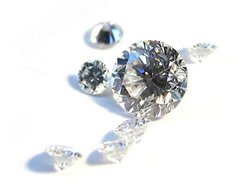 When talking about diamonds, the “4 C’s” refer to Color, Clarity, Cut, and Carat weight – factors used in determining the value of a stone.
When talking about diamonds, the “4 C’s” refer to Color, Clarity, Cut, and Carat weight – factors used in determining the value of a stone.
Cut
Cut plays an important role in a diamond’s brilliance. The popular round brilliant-cut has around 58 facets, 33 of them on top of the diamond body. There are 24 crown or star facets at bottom, which are known as pavilion facets. Many times the line connecting pavilion and crown is faceted too but these are not a part of round brilliant cut.
All the facets of a diamond should be in correct proportions to one other. When they are not, it can create undesirable visual effects like bow ties and fish eyes. “Fish eyes” make a diamond look larger and spread out and somewhat dull. A “bow tie” is a black region in the shape of a bow tie which you can see in the stone. This also detracts from the stone’s brilliance. You can see these under a magnifier such as a loupe – ask your jeweler for more information.
Color
Color is also an important factor in determining the diamond’s worth. Most diamonds seem colorless to naked eye but majority of these diamonds have tint of brown and yellow when viewed under a bright light. Colorless diamonds are of the highest value whereas traces of color depreciate its value.
An exception would be Fancy Colored Diamonds. Color in these diamonds is obvious, in fact deeper and more saturated colors are preferred. Diamonds naturally occur in yellow, brown and pink, less commonly in blue, green, red, violet and grey or black. Yellow and pink are common alternatives for engagement rings. High quality natural colored diamonds are highly prized and can be worth more than a near-colorless diamond of similar size and clarity.
Clarity
The clarity of a diamonds is judged by the location, number, type, and size of its inclusions. Inclusions are imperfections or traces of other minerals in the stone. In the higher grades, they are visible only under magnification. Inclusions are what make a diamond unique.
Certain types of inclusions can make a stone prone to breaking, and highly-included diamonds lack the brilliance and clarity of stones with less. In general, the fewer / more minor the inclusions, the higher the price.
Carat Weight
Carat is another determinant for finding out diamond’s value. Weight of the diamonds is measured in carats. Every carat is further divided in the 100 points. One carat is 0.2 grams, or about 0.007 ounces.
Carat weight alone does not determine the value of a diamond, you also need to take into account the clarity, color, and cut of the stone. A large diamond is not worth as much if it is highly included and badly cut with poor color! However since larger diamonds rarer in general than smaller ones, greater carat weight increases the value of a diamond exponentially.
![By Jim Harper (Pixel23) (Own work) [CC-BY-SA-2.5 (http://creativecommons.org/licenses/by-sa/2.5)], via Wikimedia Commons Diemond engagement ring](http://www.billmeierjeweler.com/wp-content/uploads/2014/07/320px-Diamond_engagement_ring_on_woman_hand_6313.jpg)
![By Paul Noillimrev (Own work) [CC-BY-SA-3.0 (http://creativecommons.org/licenses/by-sa/3.0)], via Wikimedia Commons Fancy cut diamonds and their shapes](http://billmeierjeweler.com/wp-content/uploads/2014/07/Fancy_cut_diamonds-paul-noillimrev-ccsa3.0-268x300.jpg)